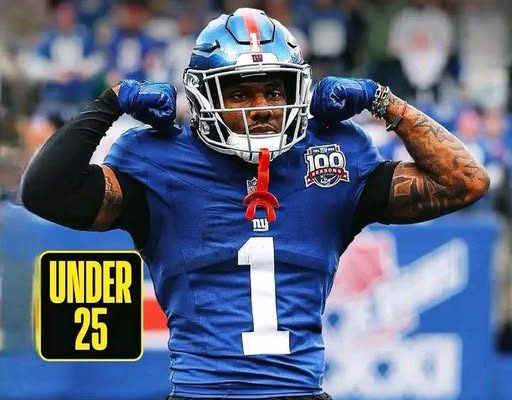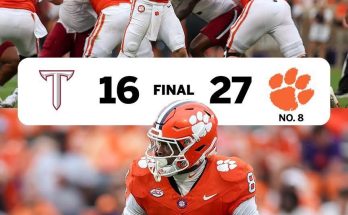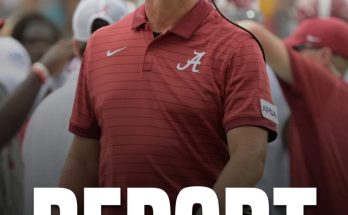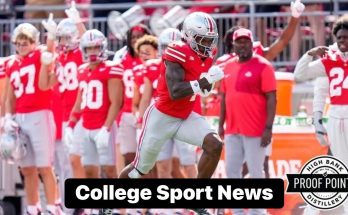In an NFL season where few things went according to plan for the New York Football Giants, one bright spot stood out so clearly that it silenced critics and turned doubters into believers—Malik Nabers. Entering the league as a rookie wide receiver selected in the first round of the 2024 NFL Draft, Nabers came in with massive expectations, burdened not only with proving his worth as a top-10 pick but also with resurrecting a Giants offense that had floundered in recent years. As it turns out, Nabers didn’t just live up to the hype—he exceeded it in spectacular fashion, becoming not just a star in his own right but the heartbeat of a team that desperately needed one.
When the Giants drafted Malik Nabers out of LSU, the hope was that they were acquiring a dynamic playmaker capable of injecting speed, creativity, and explosiveness into an offense that ranked near the bottom of the league in nearly every meaningful category. What they got instead was a transcendent talent who, in his rookie season, performed at a level rarely seen even among seasoned NFL veterans. For those who watched him closely during his college days in Baton Rouge, this may not have come as a shock. Nabers led the SEC in receiving yards during his final collegiate season, showing a blend of route running, yards-after-catch ability, and pure athleticism that made him nearly unguardable. But translating that to the NFL level is no small feat. College success doesn’t always guarantee professional greatness. And yet, from the moment Nabers stepped on the field in training camp, it became evident he wasn’t just any rookie.
From Week 1, Nabers demonstrated a confidence and control in his game that belied his age. Even as the Giants struggled to find consistency at the quarterback position due to injuries and underperformance, Nabers was electric. Defensive coordinators schemed to take him away, bracketed him in double coverage, and threw their best corners at him, yet he found ways to produce. His ability to create separation, his knack for making contested catches, and his field awareness were simply elite. But perhaps what impressed most was his fearlessness. In an NFL where rookie receivers often take time to acclimate, Nabers looked like he belonged from day one—and not just belonged, but dominated.
Statistically, his numbers told the story, but even those didn’t capture the full extent of his impact. Nabers finished the year with over 1,300 receiving yards and double-digit touchdowns, leading all rookies in both categories and placing him in the top tier of all NFL receivers. But beyond raw numbers, it was the timing and significance of his plays that made the difference. Whether it was converting critical third downs, making highlight-reel grabs in tight coverage, or taking short slants and turning them into 40-yard gains, Nabers consistently lifted the offense when it was most needed.
In fact, it’s not an exaggeration to say that Malik Nabers carried the Giants’ offense on his back for large stretches of the season. With injuries decimating the offensive line and quarterback carousel turning into a weekly headline, the one constant was Nabers. Defenses knew he was getting the ball, and yet they were powerless to stop him. That kind of dominance isn’t supposed to happen for a rookie, especially not one playing in an offense that lacked balance and support. But Nabers made it happen through sheer will, talent, and preparation.
One of the most educational takeaways from Nabers’ rookie campaign is the importance of receiver talent in today’s NFL. For years, it was believed that wide receivers, though valuable, couldn’t singularly elevate an offense. That was a theory rooted in older philosophies where running backs and quarterbacks were the central figures. But the modern NFL has changed. With rule adjustments favoring the passing game and with the proliferation of spread concepts, a dynamic wide receiver can now be the cornerstone of an offense. Nabers proved that. Even without a Pro Bowl quarterback or a consistent offensive line, his ability to win one-on-one matchups, stretch the field, and dictate coverage responsibilities forced defenses to change their approach. That ripple effect opened up opportunities for the rest of the offense—even if the Giants couldn’t always capitalize.
His presence also speaks volumes about the value of investing in skill positions through the draft. Too often, teams play it safe, opting for trench players or project quarterbacks in the early rounds, passing on elite receiver talent that could reshape their offense instantly. The Giants, to their credit, didn’t make that mistake. They bet on Nabers, and he repaid them tenfold. For young teams looking to rebuild or inject life into a stale offensive system, the blueprint is now there. Don’t underestimate the value of a game-changing receiver, especially one who brings leadership, competitive fire, and high football IQ to the table like Nabers does.
Another key educational angle from Nabers’ season is how preparation and mindset separate good players from great ones. Talent, of course, is the baseline in the NFL. Everyone is talented. What sets apart someone like Nabers is his work ethic and his attention to detail. Teammates and coaches repeatedly praised his commitment to film study, his dedication in practice, and his eagerness to learn the nuances of the game. He didn’t rest on his athleticism. He didn’t assume success would come just because of his college pedigree. Instead, he attacked his rookie year with the urgency of a veteran chasing a ring. That mindset paid off not only in his production but in the respect he earned in the locker room and around the league.
Veterans who had played a decade marveled at his professionalism. Opposing defensive backs often commented after games about how Nabers was one of the toughest covers they faced—not just because of speed or agility, but because of his technique and football intelligence. He understood leverage. He knew how to set up defenders. He was already operating with the kind of nuance that usually takes years to develop. That’s not just coaching. That’s personal drive. And that’s what makes Nabers’ rookie year so remarkable—not just the numbers, but the maturity, poise, and determination that underpinned them.
There’s also an important cultural component to what Nabers brought to the Giants. For too long, the franchise has been searching for an identity on offense. Since the days of Odell Beckham Jr., they haven’t had a true No. 1 wide receiver who could not only produce but inspire. Nabers changed that. He brought swagger back to the Giants. He made the offense watchable again. Fans who had grown disillusioned with the team’s direction suddenly had a reason to be excited. And in a league where fan engagement and team momentum can shift dramatically based on a few playmakers, Nabers’ presence mattered immensely.
His chemistry with the quarterbacks—regardless of who was under center—was also a testament to his adaptability and leadership. Whether catching passes from Daniel Jones, Tyrod Taylor, or a young backup thrown into action, Nabers made it work. He didn’t complain. He didn’t make excuses. He simply got open and made plays. That kind of consistency is invaluable, especially on a team that saw more than its fair share of chaos and adversity.
Moving forward, the question isn’t whether Nabers will be great—it’s how great he can be. If this is just the beginning, then the NFL better take notice. Because what he’s done as a rookie is not just exceptional, it’s historic. Few first-year players have ever had the kind of impact that Nabers has had on a franchise, both statistically and emotionally. He’s not just a future star—he’s already a star.
For young athletes looking to understand what it takes to succeed at the highest level, Nabers’ journey is instructive. It’s about seizing opportunities, staying humble, and never becoming complacent. It’s about maximizing your talent through discipline, focus, and relentless improvement. Nabers didn’t arrive in the NFL fully formed—he molded himself into what the Giants needed. And that transformation, even in such a short span of time, is the real story.
His success also challenges some of the long-standing assumptions about rookie development timelines. While some players do need time to grow, others—if they’re prepared, supported, and mentally wired for greatness—can make an immediate leap. Nabers shattered the ceiling on what should be expected from top-tier rookie receivers. He didn’t just contribute; he led. He didn’t just fill a role; he redefined it.
For the Giants, the path ahead remains uncertain in many areas. The quarterback situation is still fluid. The offensive line needs work. But one thing is now certain—they have a superstar at wide receiver. A player who can be the foundation of whatever offensive vision they craft moving forward. That kind of piece is rare. And the Giants would be wise to build around him, not just with talent but with structure, coaching, and continuity that allow him to flourish further.
Nabers’ rookie year wasn’t just a feel-good story or a statistical outlier. It was a statement. A declaration that greatness doesn’t have to wait. That one player, if gifted enough and committed enough, can change the fortunes of an entire offense. And that the future in New York, despite the setbacks and frustrations, has a light brighter than anyone could’ve imagined just a year ago.
Malik Nabers is that light. And what a light he is. His rookie campaign will be remembered not just as a standout year but as the year a young man from LSU put an entire NFL offense on his shoulders and carried it with grace, grit, and greatness. The league may not have been ready for Malik Nabers in 2024. But it better be ready now. Because this is just the beginning.



